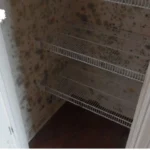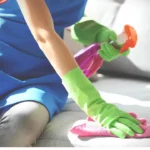With right approach, you can effectively remove mold from your couch and restore it to its former condition. In this article, we’ll explore the steps and techniques you can use to tackle mold infestation on your couch.
Mold on Your Couch
Before you can begin the removal process, it’s important to identify whether your couch is infested with mold. Look out for signs such as musty odors, visible mold growth (often appearing as black or green spots), and any signs of water damage.
Mold thrives in damp and humid environments, so if your couch has been exposed to moisture for an extended period, there’s a high chance of mold growth.
Mold not only damages your couch but also poses health risks, especially for individuals with allergies or respiratory conditions. Prolonged exposure to mold spores can exacerbate existing health issues and lead to new ones.
Therefore, it’s crucial to address mold infestation promptly and effectively.
Preparing for Mold Removal
Before you start removing mold from your couch, gather the necessary supplies. You’ll need a vacuum cleaner with a HEPA filter, a brush or sponge, mild detergent, white vinegar, baking soda, tea tree oil, and clean cloths.
Additionally, ensure proper ventilation in the room by opening windows and using fans to prevent the spread of mold spores.
Take precautions to protect yourself during the removal process. Wear gloves, a mask, and protective eyewear to avoid direct contact with mold and inhaling mold spores. If you have any underlying health conditions, consider wearing a respirator for added protection.

Steps to Remove Mold from Your Couch
- Step 1: Vacuuming the Couch
Begin by vacuuming the entire surface of the couch, including cushions, seams, and crevices, using a vacuum cleaner equipped with a HEPA filter. This helps remove loose mold spores and debris from the surface.
- Step 2: Treating the Affected Areas
Mix a solution of mild detergent and water, then dampen a clean cloth with the solution and gently blot the mold-infested areas of the couch. Avoid oversaturating the fabric to prevent further moisture retention.
- Step 3: Scrubbing the Mold-Infested Areas
For stubborn mold stains, create a paste using baking soda and water and apply it to the affected areas. Use a brush or sponge to scrub the mold gently, then rinse the area with clean water and allow it to dry completely.
- Step 4: Drying the Couch Thoroughly
After cleaning, use a fan or dehumidifier to dry the couch thoroughly. Ensure that the room is well-ventilated to promote faster drying and prevent mold from returning.
Natural Remedies for Mold Removal
In addition to traditional cleaning methods, you can use natural remedies to remove mold from your couch.
- Using Vinegar: White vinegar is known for its antifungal properties. Spray undiluted vinegar onto the moldy areas of the couch and let it sit for an hour before wiping it clean with a damp cloth.
- Applying Baking Soda: Baking soda not only absorbs moisture but also helps eliminate odors. Sprinkle baking soda over the mold-infested areas of the couch, let it sit for a few hours, then vacuum it up.
- Utilizing Tea Tree Oil: Tea tree oil is a natural antiseptic that can effectively kill mold spores. Mix a teaspoon of tea tree oil with a cup of water in a spray bottle and apply it to the moldy areas of the couch. Allow it to dry without rinsing.
Professional Mold Removal Services
If the mold infestation on your couch is extensive or if you’re unable to remove it yourself, consider hiring professional mold removal services. A qualified mold remediation company will have the expertise and equipment to safely and effectively remove mold from your couch without causing further damage.
When choosing a mold removal company, ensure they are certified and experienced in handling mold remediation projects. Request references and compare quotes from multiple companies to find the best option for your needs and budget.
Preventing Future Mold Growth
Once you’ve successfully removed mold from your couch, take steps to prevent it from returning in the future.
- Regular Cleaning and Maintenance: Vacuum your couch regularly and clean spills promptly to prevent moisture buildup. Wash removable covers and cushions according to the manufacturer’s instructions.
- Proper Ventilation and Humidity Control: Keep the room well-ventilated by opening windows and using exhaust fans, especially in areas prone to moisture such as bathrooms and kitchens. Use a dehumidifier to maintain indoor humidity levels below 60%.
Conclusion
Removing mold from your couch is essential for maintaining a clean and healthy living environment. By following the steps outlined in this article and utilizing natural remedies or professional services when necessary, you can effectively eliminate mold infestation and prevent it from recurring.
Remember to take precautions to protect yourself during the removal process and prioritize regular cleaning and maintenance to keep your couch mold-free.
FAQs
- How can I tell if my couch has mold? Look out for musty odors, visible mold growth, or signs of water damage on your couch.
- Are there any health risks associated with mold on couches? Yes, mold exposure can trigger allergies and respiratory issues, especially for sensitive individuals.
- Can I use bleach to remove mold from my couch? Bleach is not recommended as it can damage upholstery and may not effectively eliminate mold spores.
- How often should I clean my couch to prevent mold growth? Aim to vacuum your couch at least once a week and address spills and stains promptly to prevent moisture buildup.
- Is it possible to prevent mold from returning after removal? Yes, proper cleaning, maintenance, and humidity control can help prevent mold from recurring on your couch.


